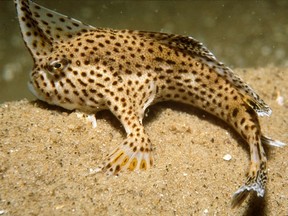The rare fish is known to use its ‘hands’ to walk on the sea floor and cares for its eggs with the ‘fingered flippers’
Article content
A runner on a beach in Tasmania has surprised scientists by stumbling across an elusive fish that was previously believed to be locally extinct.
Kerri Yare was running on the shores of Primrose Sands when she spotted a critically endangered spotted handfish. The fish uses its pectoral fins to walk on the sea floor and also cleans and cares for its eggs with the “fingered flippers.”
Advertisement 2
Article content
While the fish was dead, and had washed up on the beach, scientists say the discovery is all they need to renew research in the area.
“We did look a few years ago but we didn’t find a single fish,” said research technician Carlie Devine in a news release from The Commonwealth Scientific and Industrial Research Organisation (CSIRO), an Australian Government agency responsible for scientific research.
“This gives us cause to go looking again.”
Recommended from Editorial
According to CSIRO, finding the small and solitary handfish in the wild is like finding a need in a haystack. Before Yare’s discovery, scientists believed the species had been extinct at Primrose Sands for nearly 20 years.
The spotted handfish, known scientifically as Brachionichthys hirsutus, is one of seven handfish species endemic to Tasmania and the Bass Strait. While once abundant on Tasmania’s east coast, the population has decreased sharply over the past three decades.
Yare initially thought the specimen, which measured about 9 centimetres, was a toadfish, which is known to inhabit coastal and estuarine waters.
Article content
Advertisement 3
Article content
According to Devine, there are only about 2,000 spotted handfish estimated to be left in the wild and the fish has been on The International Union for Conservation of Nature (IUCN) red list since 1996.
“They are rare and elusive. Prior to the 1990s, spotted handfish were easily found. However, the population has separated and there are now only nine isolated populations,” said Devine.
Scientists have been working to conserve the species since the IUCN listing, which is intended to guide conservation actions to prevent further extinctions.
The collaborative effort includes CSIRO, the University of Tasmania, Australian and state governments and the Derwent Estuary Program, located in southern Tasmania. The estuary is believed to be home to local populations of handfish at nine small sites.

The spawning and breeding habits of handfish are still being understood. Scientists know that they aggregate to breed halfway through the year, but they’re not sure where they go. To learn more, they’ve introduced artificial spawning habitats, areas where the fish can lay eggs where natural habitats have been destroyed.
Advertisement 4
Article content
The fish are threatened by coastal infrastructure development and the invasive North Pacific seastar, which is native to the coastal waters of northern China, Russia, Japan and Korea, and destroys the habitats and spawning areas of handfish. The seastar is believed to have been introduced to Tasmanian waters through ballast water discharges from ships and as larvae transported on hulls of vessels.
Handfish are also threatened by dredge fishery operations, becoming bycatch while scallops are being hunted.
To ensure the species doesn’t go extinct, scientists have started a breeding program from fish that were collected in the wild and now live in commercial aquariums.
Once the juveniles have grown, they are returned to natural habitats in hopes that they can increase their numbers in the wild.
“Through this program, we’ve already released a small number of juveniles into the wild and we are excited to see the ongoing impact of our work,” said Devine. “We’re not done yet.”
Our website is the place for the latest breaking news, exclusive scoops, longreads and provocative commentary. Please bookmark nationalpost.com and sign up for our newsletters here.
Article content








